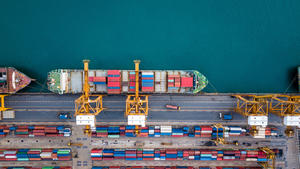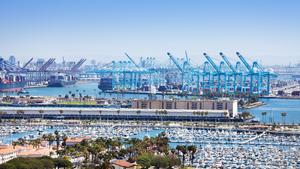The supply chain is broken, and there’s no easy fix. What’s contributing to the delays, and when will they get better? We’ve tapped furniture industry veteran and longtime editor Ray Allegrezza for a multipart series that unpacks the challenges at hand. In the third installment, he’s taking a closer look at the causes and impacts of the worldwide shipping container shortage.
The supply chain is an intricate and complex entity, yes, but it can essentially be broken down into four major components: Somebody makes something. That something gets shipped somewhere. Somebody receives that something and distributes it for sale. And finally, somebody buys it.
That’s the perfect-world scenario. But the world isn’t perfect—and with the ongoing and escalating shortage of containers, neither is the global supply chain.
One of the year’s biggest supply chain wrinkles has been the shortage of shipping containers. Another of the pandemic’s many “gifts,” the dearth of containers can be directly linked to ongoing issues including long lead times, soaring freight and transportation costs, increasingly empty retail shelves, and higher prices at the cash register.
The problems associated with the shortages grew at the same speed as the COVID-19 virus. As the pandemic rapidly spread—first through China, then across the world—it triggered waves of lockdowns, stalled production and shuttered manufacturing facilities. It also resulted in a big buildup of empty containers at ports.
Freight carriers only want to set sea with full ships. So as the stockpile of empty containers increased—coupled with the dramatically reduced production from manufacturers worldwide—carriers responded by greatly reducing the number of boats they would float. As an alternative to paying to operate ships that were not at capacity, many carriers also began to bypass smaller ports or cut down on port space to save on operating costs.
Empty containers sitting around in ports is bad for business—but it gets worse when those containers are not able to get back to China. The problem reached a tipping point as it became increasingly clear that the infrastructure needed to get them back to China was simply not in place.
The trade imbalance with China is nothing new—in 2020, the U.S. imported $434.7 billion worth of goods from the country and exported only $124.5 billion in the opposite direction. According to Sea-Intelligence, a firm that provides market intelligence on global supply chain issues, even before the pandemic hit, there was an imbalance (upwards of 45 percent) of containers in Asia caused specifically by empty ones stockpiled in North America. Today, the imbalance has become even more egregious, increasing to 55 or 60 percent. In a recent blog post on key supply chain impediments, the company wrote: “None looms larger than the global shortage of containers, resulting in declined bookings, cargo rolling, massive rate hikes, and consequent bad blood between shippers and carriers.”
Another cause of container shortages involves the dramatic boom in consumer demand, thanks to the steady growth of e-commerce sales and long lockdowns in 2020. Further complicating the situation are the myriad other pandemic-related factors I’ve covered before: dockworker and driver shortages, port restrictions and congestion, and more.
While labor shortages at all levels play an indirect role in container shortages, Sea-Intelligence points out that longshoremen with COVID-19 especially exacerbate the issue. According to the company, “Many longshoremen are infected, resulting in most vessels that would normally be assigned eight gangs now only getting four. This causes enormous congestion, with vessels up and down the coast waiting for a berth in ports that are already notorious for low productivity.”
Late last month, reacting to a spike in new cases, China, as part of its “zero-COVID” policy, imposed a mandatory seven-week quarantine for cargo vessels and their crews planning to return to China. According to sources close to the action, even cargo vessels that have refreshed their crews in ports outside China have to wait 14 days before being allowed to dock there. As a result, most of the ships have been forced to reroute, adding new delays and costs, and further restricting container access. Such a move would likely be far less disruptive to the supply chain in smaller countries. But with a shipping footprint as large as China’s, this new quarantine policy could present a new set of problems.
With no end in sight to the container shortage, some industry insiders had hoped for a production boost by major Asian container manufacturers, including CXIC, Singamas, and CIMC, which are responsible for upwards of 80 percent of the global container supply. But the world may not want to hold its collective breath, according to Drewry Maritime Research. While the agency predicts an increase in container production by the end of this year, it’s marginal—less than 7 percent—and even that hasn’t yet occurred.
In the meantime, global production has increased by an estimated 6.5 percent in 2021, and the price of a new container has increased exponentially. And, unsurprisingly, some are convinced that container makers are enjoying the view from the catbird seat and see no reason to dramatically increase production.
While I can’t say which side is right, it’s a certainty that containers will remain a premium commodity through at least the first half of 2022.
Homepage image: © aerial-drone/AdobeStock
____________
Ray Allegrezza is the executive director of the International Home Furnishings Representatives Association, which was founded in 1934 to focus on the needs of the industry’s sales reps. An industry veteran with more than three decades of editorial, publishing and marketing experience in the home furnishings sector, Allegrezza was the editor in chief of Furniture Today from 1995 to 2014.





























